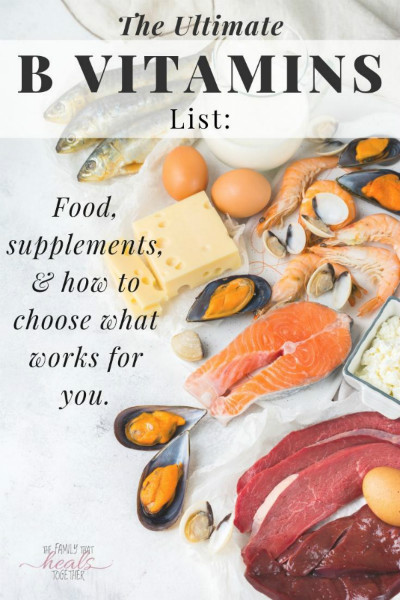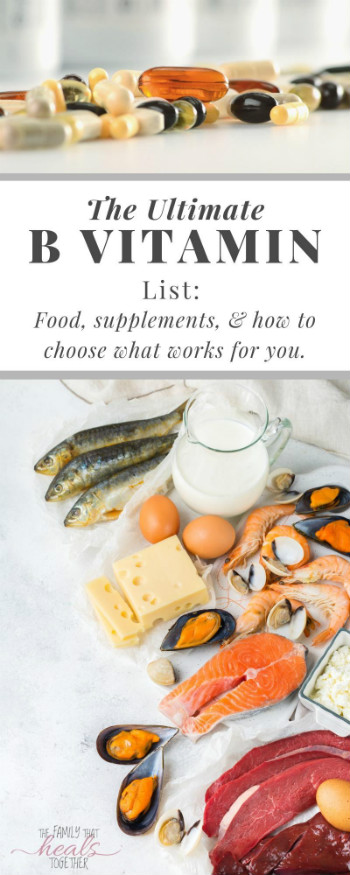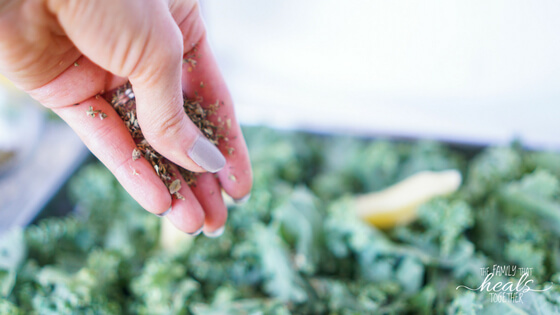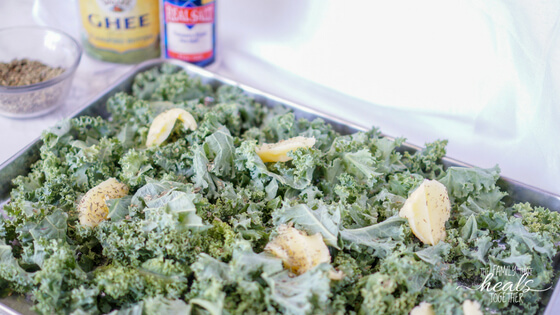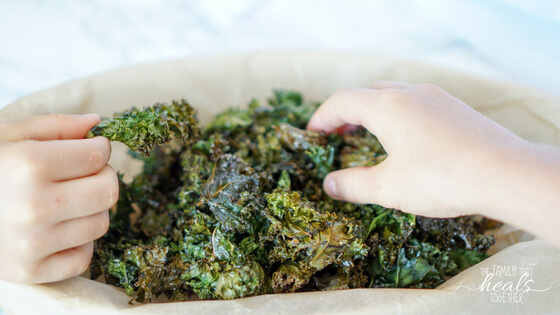If you’ve heard folks raving about liver (the organ meat) or vitamin B12 shots, you may wonder, “What’s the big deal with vitamin B?” As it turns out, a lot. Our ultimate vitamin B list explains why B vitamins matter, what vitamin B deficiency looks like, and the different types of B vitamins you’ll find at the market and in food.
B vitamins are a family of nutrients that play a significant role in the maintenance of good health and can be key in managing a variety of chronic health issues. With such diverse applications, it’s little wonder why interest in these nutrients has exploded.
What are the symptoms of a lack of vitamin B?
Since each B vitamin serves a unique function in the body, a deficiency in one B vitamin will look different than a deficiency in another. Likewise, symptoms of the deficiency will depend on which of the B vitamin list is lacking.
- Vitamin B12: The symptoms of vitamin B12 deficiency can include anemia, weakness, fatigue, confusion, and a variety of psychological and neurological issues. B12 deficiency has been known to mimic conditions such as Alzheimer’s disease, dementia, MS, learning disorders, ASD, even infertility and autoimmune disease.
- Vitamin B9: Vitamin B9, more widely known as folate, plays an important role in the methylation pathway. As such, folate deficiency can contribute to birth defects. Symptoms of a folate deficiency can also include anemia, heart palpitations, trouble concentrating, and shortness of breath. During pregnancy. too little folate can lead to growth restriction, preterm birth, and low birth weight.
- Vitamin B6: Signs of a vitamin B6 deficiency can look like B12 deficiency. Like B12 deficiency, symptoms include anemia, confusion, and depression. But unlike B12 deficiency, symptoms of B6 deficiency include weakened immune function and skin conditions, especially cracks around the mouth.
- Vitamin B3: Also known as niacin, vitamin B3 deficiency can have some serious symptoms. Extreme deficiency can result in pellagra, a condition marked by skin inflammation, hallucinations, and digestive distress. You’ll also see inflamed mucous membranes, skin lesions, impaired of cognitive function, psychosis, and anorexia.
- Vitamin B2: Often referred to as riboflavin, vitamin B2 deficiency has gained some notoriety lately due to its connection to the function of the MTHFR gene and its role in methylation. Symptoms can include psychological and neurological issues such as ADHD, ASD, schizophrenia, bipolar, fibromyalgia, and migraines.
How many B vitamins are there?
Vitamin B is actually a family of eight nutrients: B1, B2, B3, B5, B6, B7, B9, and B12. Together, they form the vitamin B complex.
Vitamin B list
- B1, also known as thiamin.
- B2, more commonly known as riboflavin.
- B3, also known as niacin, nicotinic acid, niacinamide, or nicotinamide.
- B5, otherwise known as pantothenic acid and sold as D-pantothenic acid, dexpanthenol, zinc pantothenate, and calcium pantothenate.
- B6, also known as pyridoxine, pyridoxal, or pyridoxamine.
- B7, more commonly known as biotin and formerly known as vitamin H.
- B9, more commonly known as folate and sold as folic acid, folate, methylfolate (various names), and folinic acid.
- B12, also known as cobalamin and sold as cyanocobalamin, methylcobalamin, hydroxocobalamin, and adenosylcobalamin.
What does each B vitamin do?
Each B vitamin works differently in the body. You may be able to determine which ones you need based on the vitamin B list below.
Thiamine (B1) helps convert food into energy. The body needs vitamin B1 to produce ATP, which is needed to transport energy within cells. It also supports immune system function, plays a role in the production of stomach acid, regulates electrolytes in the body, and plays a role in myelin development (as in the myelin sheath found on the nerve).
Riboflavin (B2), like all B vitamins, helps the body convert food into energy the body can use. Especially carbohydrates. It also helps the body to use protein and fat, helps maintain the health of the immune system and nervous system, contributes to healthy hair, skin, eyes, and liver, and is important for reproductive function. Uniquely, riboflavin is known to help decrease the effects of aging on the brain, particularly in the area of memory loss.
Niacin (B3) also helps with the conversion of carbohydrates into usable energy for the body. In addition, it affects how the body processes cholesterol, healthy digestive and neurological function, and promotes healthy skin, hair, and eyes.
Pantothenic acid (B5) is closely associated with the body’s metabolism. It too supports healthy skin, hair, eyes, and liver. Uniquely, we require vitamin B5 to produce red blood cells and sex hormones. Because it is important for supporting the adrenal gland, it also helps to relieve stress. Pantothenic acid shares many similarities with niacin in how it affects cholesterol levels.
Vitamin B6 (pyridoxine) helps with energy production by helping the body to metabolize protein and promote stamina. B6 is very important for brain health and plays a significant role in the body’s production of vital neurotransmitters and mood-regulating hormones. B6 supports your immune system. What’s more, it helps reduce the symptoms of PMS and morning sickness.
Biotin (B7) can benefit your skin, hair, and nails. Some early research also shows a positive link between biotin supplements and improved symptoms of type 2 diabetes, particularly in improving blood sugar levels and reducing nerve pain associated with the disease.
Folate (B9), like B6, has a strong affinity for the brain and works with B12 to regulate red blood cell production. With B6 and B12, folate is also important for regulating levels of pro-inflammatory homocysteine. Well-known for its connection to a healthy pregnancy and preventing neural tube defects in a developing fetus, folate is especially important during pregnancy.
Vitamin B12 (cobalamin) has a strong affinity for the nervous system. It helps to maintain healthy nerve cells and overall good nervous system function. Because it supports the production of red blood cells, a lack of B12 can lead to pernicious anemia, often as the result of an autoimmune condition. Vitamin B12 can also reduce fatigue.
How to choose a B vitamin based on your needs
When looking at B vitamin supplements, you want to select the most bioavailable form of each. As you can see above, each B vitamin serves a different purpose.
Here are a few of our favorites:
For memory and focus: Alpha Brain
For mood and relaxation: New Mood
B complex for energy and focus: Active B Complete
The above are suggested because they’re combined with herbal and other nutritional support and do not contain unreasonably high amounts of B vitamins like some supplements.
Which vitamin B is best for energy?
While all the B vitamins are important for energy production, B12 is of particular note.
Lack of B12 can lead to fatigue, poor mood, and even mental performance issues. B12 plays a pivotal role in building new DNA for new cells and producing red blood cells, both of which support energy levels.
We like Active B Complete for good, clean energy.
What is the best time to take vitamin B complex?
B vitamins are crucial for food metabolism and energy production. So it follows that the best time to take vitamin B complex is in the morning when energy is at a natural high. You also want to take a vitamin B complex with food.
A note on folate
Folate can come in a variety of forms: folic acid, folate, methylfolate, folinic acid. Folic acid is usually a synthetic form of folate created in a lab. It has the poorest bioavailability and may be problematic for those with impaired methylation due to illness or genetic mutation.
Folate is the naturally-occurring form that is found in food.
Unfortunately, folate is exceptionally unstable and oxidizes very quickly. Oxidized folate becomes folic acid in form and function. The process of turning food-based folate into a supplement destroys any advantage there was for using food-based folate instead of lab-created folic acid in the first place.
Methylfolate and folinic acid are the two most bioavailable forms of folate to take as a supplement.
Methylfolate is the biologically active form. Folinic acid is the metabolically active form of folate.
Note: While rare, those with over-methylation issues would want to steer clear of methylfolate as it can make you feel worse.
As with so many other things when it comes to our health, one size does not fit all.
Watch out for vitamin B overdose
B vitamin supplementation is usually beneficial, but there are some things to watch out for. Since B vitamins are water-soluble, overdosing on them is often difficult. But that doesn’t mean that taking exceptionally high doses of B vitamins is safe.
For example, excessive supplementation of folate can mask the symptoms of pernicious anemia (B12 deficiency), which can be a red flag for other health issues.
Likewise, one of the most notable side effects of high dose niacin supplementation is the “niacin flush.” This happens as the capillaries expand and the increased blood flow to the skin causes a warm, red, tingling, itching or burning sensation.
It’s short-lived and usually considered harmless.
However, high doses of niacin can contribute to high blood sugar, low blood pressure, fatigue, headaches, rashes, and liver damage, diarrhea, and vomiting.
You also want to watch out for overdose of B6. Too much, and it can cause nerve toxicity, numbness, and tingling, some of which may be irreversible if the overdose is continued long term.
What foods are high in B vitamins?
Certain foods are fabulously rich in B vitamins. And foods high in B vitamins have the added benefit of co-factors that support the use and uptake of nutrients.
Below are some B vitamin foods that you can start adding to your diet today.
- Thiamine (B1): Nutritional yeast, seaweed, sunflower seeds, macadamia nuts, and legumes.
- Riboflavin (B2): Beef liver, yogurt, milk, spinach, almonds, tomatoes, and eggs.
- Niacin (B3): Chicken, liver, tuna, turkey, salmon, sardines, beef, and sunflower seeds.
- Pantothenic acid (B5): Chicken liver, sunflower seeds, avocados, portobello mushrooms, salmon, and lentils.
- Vitamin B6: Turkey breast, grass-fed beef, pistachios, tuna, pinto beans, avocado, chicken breast, and blackstrap molasses.
- Biotin: Almonds, beef liver, brewer’s yeast, brown rice, brassicas, cheese, and chicken.
- Folate (B9): Beef liver, spinach, black-eyed peas, asparagus, Brussels sprouts, romaine lettuce, and avocado.
- Vitamin B12: Beef liver, sardines, mackerel, lamb, wild salmon, and feta cheese.
Why vegans are at risk of developing a vitamin B12 deficiency
Vitamin B12 is unique because you can only find it in animal-based foods.
So how do vegetarians get vitamin B12?
Most vegetarians and vegans use nutritional yeast as their source of B12.
Nutritional yeast provides B12 because manufacturers fortify it with the vitamin. Nutritional yeast does not naturally contain or provide vitamin B12 and not all brands are fortified. Of the brands that are fortified with B12, large quantities would need to be consumed in order to meet the minimum RDA.
Nutritional yeast can cause issues for those sensitive to glutamate due to MSG contamination or in response to the presence of glutamic acid naturally found in nutritional yeast. Further, many with gut health issues, especially Crohn’s or IBD, or systemic yeast overgrowth have issues with nutritional yeast.
In addition to nutritional yeast, the other option is to supplement. As I mentioned above, methylcobalamin is the most bioavailable form of vitamin B12.
In conclusion, the family of B vitamins is crucial for our health and well-being in almost every bodily function.
Eating a nutrient-dense diet with meat and even liver (see the vitamin B food list above) can provide all the B vitamins that you need. If you need extra support during pregnancy or a particularly stressful time in life, seek out B vitamins that work together as a complex and bioavailable form that your body can easily use.





